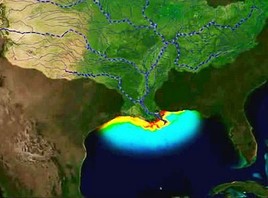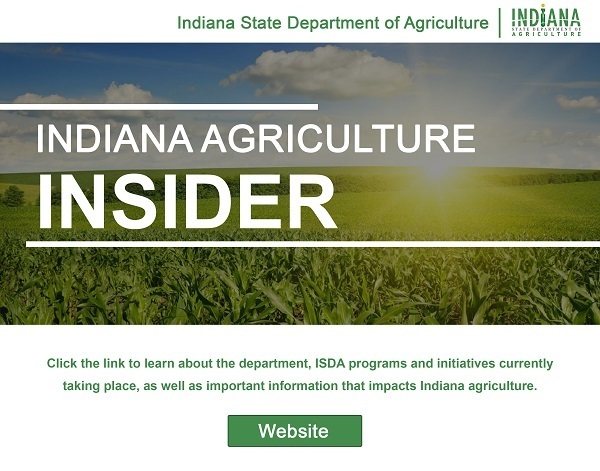Indiana Agriculture Insider
State of Indiana sent this bulletin at 12/30/2016 07:15 PM EST
|
 To tackle this issue in the Gulf, a task force was created in 1997 to understand the causes and effects of the nutrient pollution; coordinate activities to reduce the size, severity, and duration; and improve the effects of low oxygen, or hypoxia. Today, the Hypoxia Task Force, made up of state and federal agencies (including Indiana) and tribes, provides executive level direction and support for coordinating the actions of participating organizations working on nutrient management within the Mississippi River/Gulf of Mexico Watershed. Since its inception, the task force has been able to provide new programs, funding and technical tools to support and reduce excess nutrients from entering the Gulf, such as the Gulf Hypoxia Action Plan 2008. From the time the plan was released, which was later updated in 2013, each state has developed their own nutrient reduction strategy, in collaboration with their partners, to better manage the issue. Click here to learn more about the Indiana Nutrient Reduction Strategy. |
 In 2015, the task force announced that it would retain the original goal of reducing the areal extent of the Gulf of Mexico hypoxic zone to less than 5,000 square-kilometers and extend the time of attainment to 2035. The task force also for the first time agreed on an interim target of a 20 percent nutrient load reduction by the year 2025. This year, the task force met in Louisiana to discuss the progress that has been made by the states, collaborate on best management practices and to review the updated federal strategy. From Minnesota to Wisconsin, many states have implemented a variety of successful projects and programs to reduce nutrient loads entering the Gulf. To read some of the success stories, click here. Although our work is ongoing and there is no quick solution, we will continue to assist farmers with their voluntary conservation practices and work with our partners to address this issue. To learn more about ISDA's Division of Soil Conservation, and the many conservation programs and grants available, such as INfield Advantage and Clean Water Indiana, click here. |
KEY DATES:
January 2
Office closed - New Year's
January 3
Legislative session begins – Senate
January 4
Legislative session begins - House
January 16
Office closed - Martin Luther King, Jr. Day
January 19
State Fair Commission meeting
January 21-22
Fantastic Food Fest, Indianapolis
January 26-27
Agribusiness Council of Indiana Annual Conference, Indianapolis
January 28
Certified Livestock Producer Training, Greensburg
IMPORTANT UPDATES:
Certified Livestock Producer Trainings
We have three more trainings left this winter for Indiana livestock producers
interested in completing the Certified Livestock Producer Program.
To register for one of the trainings listed below, an application must be filled out, which can be found by clicking here, and returned to Kimmi Devaney at KDevaney@isda.in.gov or mailed to: One North Capitol, Suite 600, Indianapolis, IN 46204. Each training will start at 10 a.m. and last until 3 p.m.
- Jan. 28, 2017 in Greensburg, Ind. (Decatur County)
- Feb. 15, 2017 in Monticello, Ind. (White County)
- Feb. 21, 2017 in Loogootee, Ind. (Martin County)
Fantastic Food Fest
The Indiana State Department of Agriculture’s Indiana Grown initiative is proud
to sponsor the second annual Fantastic Food Fest, the state’s largest
interactive food and beverage event. Taking place Jan. 21-22 at the Indiana
State Fairgrounds and Event Center, more than 100 Indiana Grown members will be
showcasing their products in front of thousands of Hoosier consumers.
IN THE NEWS:
Holcomb Reappoints McKinney to Head ISDA
Brazil, Sullivan County share in better water grants
Indiana Poultry Producers Making a Difference with
Donations
ISDA hosts trainings for livestock producers
McKinney among Purdue Extension award winners
MarketReady training to be offered at 2017 Indiana Hort
Congress
Indiana Pork Donates Ground Pork Meals to Feeding
Indiana's Hungry
Indiana Dept of Ag Pushing Trade to Help Boost Bottom
Line
Holcomb Leading Trade Mission to U.K.
Indiana Farm Family of the Year: It's Miller Time
AGRITOURISM DESTINATION:
French Lick Winery

French Lick Winery is a family owned winery located within the Indiana Uplands and is one of Indiana's premier wineries and a favorite stop along the Indiana Uplands Wine Trail. Their restaurant, Vintage Café, features fresh, homemade Italian cuisine in the relaxed atmosphere of the French Lick Winery tasting room.
INDIANA GROWN RECIPE:
Mexican Christmas Punch

Ingredients:
1 gallon of water
1 package of frozen Mexican punch fruit
2 cups of brown sugar
2 packages of spiced apple cider mix
Easley Warm Mulled Wine
Instructions:
In a medium sized pot, combine water, cinnamon, sugar, apple cider, and fruit over medium to high heat for about 45 minutes or until the fruit is tender. Serve in a mug and add Easley Warm Mulled Wine to your liking. Serve Warm.
CONTACT ISDA:
Indiana State Department of Agriculture
One North Capitol Avenue, Suite 600
Indianapolis, IN 46204
317.232.8770
317.232.1362 FAX
Communications@isda.in.gov

Indiana State Department of Agriculture - One North Capitol Avenue, Suite 600 - Indianapolis, IN 46204




